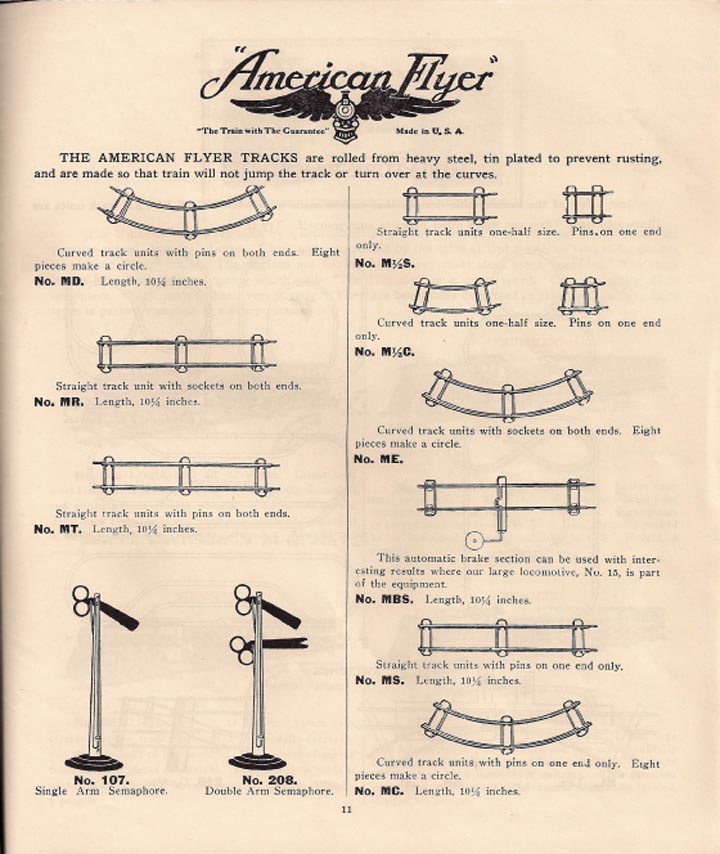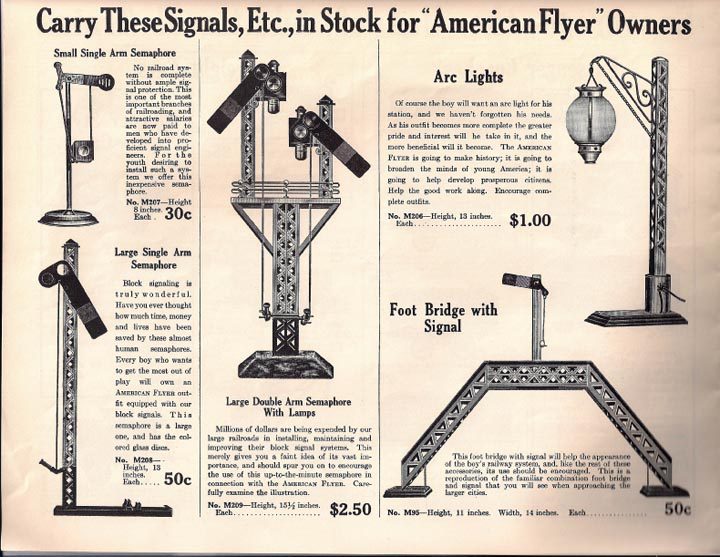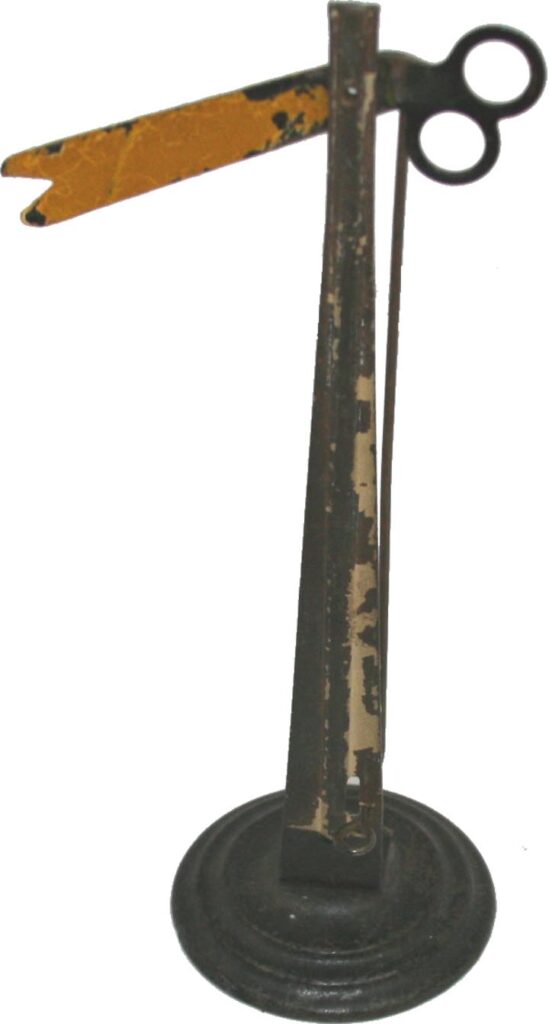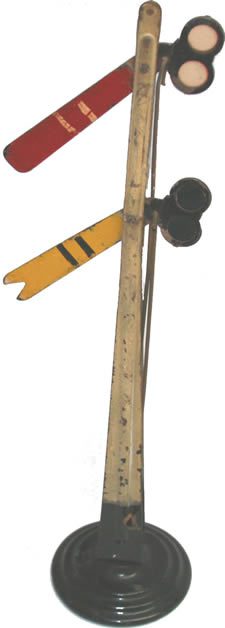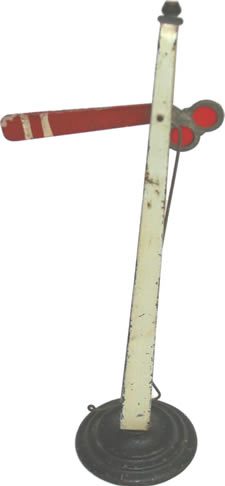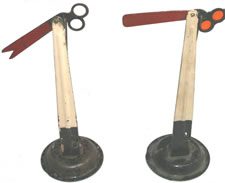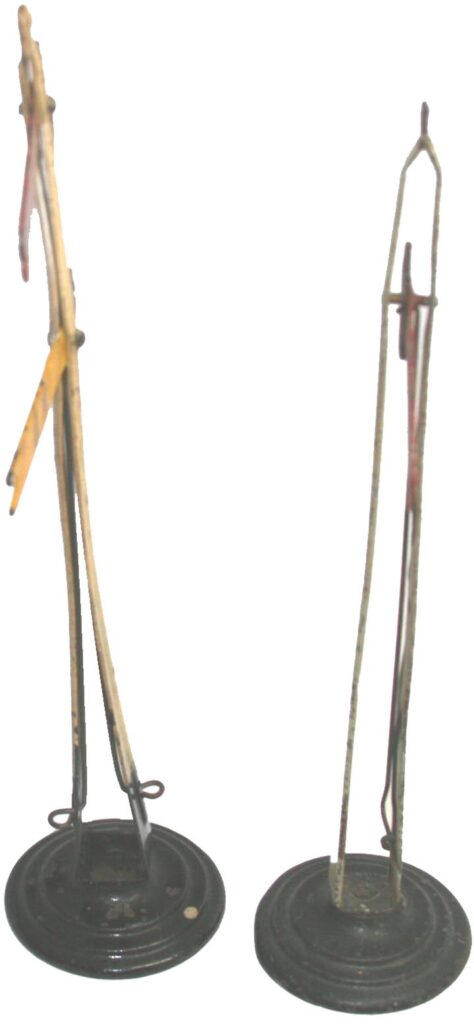American Flyer’s First Self Made Accessories?
107 AND 208 Semaphores c. 1915-1916
By Leon Sweet
In 1907, as a newcomer to the toy train market, American Flyer initially was not making their own accessories. The first accessories cataloged by American Flyer c. 1909-1910, appear to be of German origin, as the catalog pictures show items similar to those offered by Bing and other German manufacturers. The 1914 American Flyer catalog shows the German manufactured items and lists a single blade semaphore as M207 and the double blade semaphore as M208 and all other accessories with an “M” numbering system.
In the 1915-1916 era American Flyer catalog, the stations / buildings still feature the “M” coding; however, the single blade semaphore is listed simply as 107 and the double blade semaphore is listed as 208. In the 1918-1919 American Flyer catalog, the number of the semaphores change to 207 and 208, where they will remain though the early to mid 1930s.
I personally never thought very much of the single and double blade manual semaphores that American Flyer made, that is until I purchased a grouping of 6 208 semaphores in order to complete a boxed set that was missing a semaphore. After unwrapping my purchase, I discovered that one of the semaphores was unusually heavy. Examining it closer, I discovered that it had a cast iron base. Oddly, the semaphore also had a fish-tail cut to the lower semaphore blade. Never having observed a semaphore like this, I consulted my American Flyer catalogs, and there in the 1915-1916 American Flyer catalog I discovered a drawing of a semaphore that had a base resembling the cast iron base and had a fish-tail cut to the lower semaphore blade.
In comparing the early 208 semaphore to the later 208 semaphores, I realized that the basic design/stamped parts were the same, with only the base being cast iron instead of stamped steel and the lower semaphore blade having a fish-tail cut. Therefore, I reasoned it must be an American Flyer item. I asked friends if they knew about the early design and nobody I talked to had observed one. At some point later, I observed an Ives Greenberg guide that showed a picture of an Ives 107-D semaphore with a cast iron base. The Greenberg’s guide listed 107-D and 107-S (Double and Single arm semaphores) that was cataloged from 1907 through 1930, with the earliest versions described as having a cast iron base. Eventually, I found an Ives semaphore with cast iron base and made an unusual discovery, the bases were identical and the semaphore blades had the same shape. My guess is that American Flyer used the Ives semaphore with cast iron base as a model for their semaphore, but changed the mast and operating lever design. Then after the initial production of the item, American Flyer realized that the cast iron base was too expensive to produce and changed the semaphore to have a stamped steel base.
After reasoning out how the item was designed, my next quest was finding a 107 semaphore to examine. The 107 semaphore only appeared in the 1915-1916 American Flyer catalog, as it was the M207 in the 1914 American Flyer catalog and was the 207 semaphore in the 1918-1919 American Flyer catalog. I knew that finding one might be difficult as, since discovering the early 208 semaphore with cast iron base, I have only seen 4 of them. However, I knew that the key to the 107 semaphore would be the cast iron base with a single semaphore arm.
Finally, I was able to purchase a 107 semaphore in November 2010. Someone had written “Very Old A F” on the bottom of the item, so the seller listed it that way. The 107 semaphore is interesting due to its crude design, which features a single mast pole (208 has 2 halves that join at the top and bottom) which is the same mast used on the 208, but is cut off square just above the lower semaphore blade. This is particularly interesting because the later 207 semaphores use a different mast than the 208 semaphores. The mast on the later 207 semaphores is rounded at the top and the embossing ends just below the semaphore blade.
I know that the 107 semaphore I have is original, as the pin holding the mast to the cast iron base is un-modified and is hammered so that only one mast was attached, as opposed to connecting two masts as on a 208 semaphore.
Finally, as I was writing this article, I realized why the 107 semaphore appeared only in American Flyer’s 1915-1916 catalog. I can only guess that having an American Flyer semaphore that was the same number as an Ives semaphore must have caused some confusion and may have upset the management of both companies.
An interesting note, is that somewhere along the line, I acquired an early American Flyer 207 semaphore that has a fish-tail cut to its blade. I can only surmise that there were leftover fish-tail cut blades that were used on some of the post 1915-1916 American Flyer 207 and 208 semaphores.
Since the basic design of the 208 semaphore remained unchanged from 1915-1916 through the early to mid 1930s, it is my opinion that these two semaphores are likely the first accessories that American Flyer made themselves. The reasoning behind American Flyer making their own accessories is likely due to the following two factors.
1 American Flyer was experiencing a growth spurt around 1914 – 1916 and had moved into a larger factory on South Halsted Street, where they would have had the manufacturing capacity to make more of their own items and;
2. World War I was likely making it somewhat difficult to obtain the German accessories that had been cataloged through their 1914 catalog and were included on a limited basis in their 1915-1916 catalog.
This is further evidenced because in the 1918-1919 American Flyer catalog the German made accessories had disappeared.

